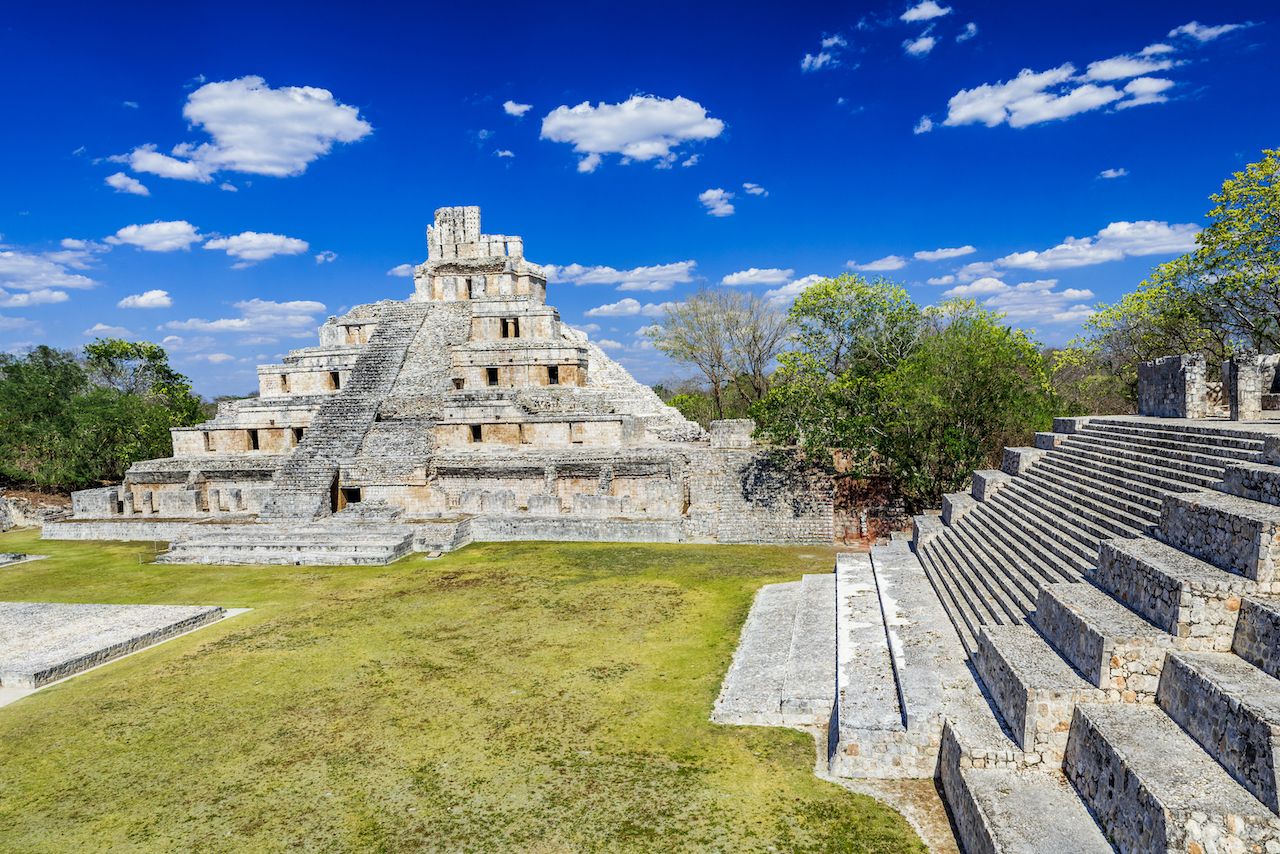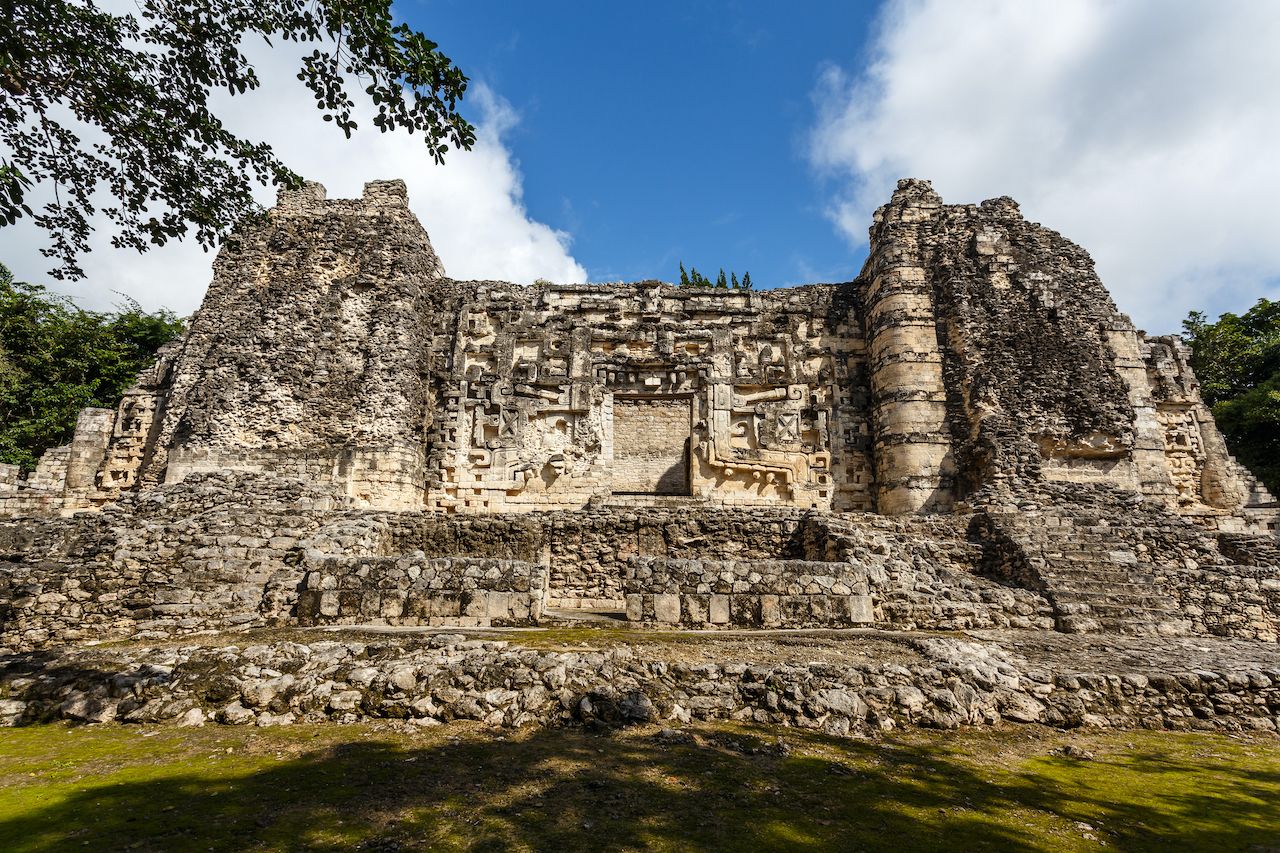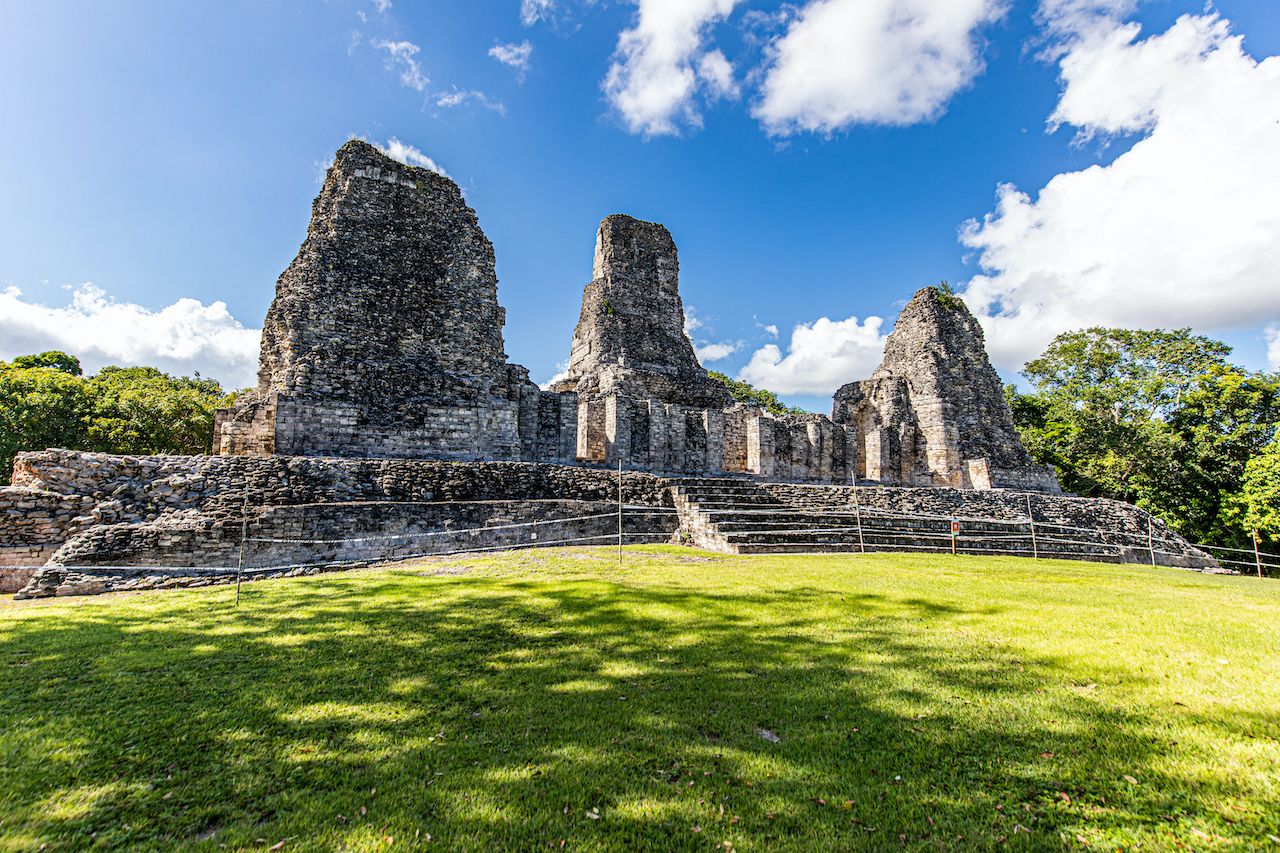
Every year, Mexico’s Yucatán Peninsula is visited by millions of people who cannot resist the region’s white-sand beaches, crystal clear Caribbean waters, and beautiful wildlife. But no trip to the Yucatán Peninsula would be complete without taking a small step back in time to acknowledge the region’s past life when the Mayans called the Yucatán Peninsula home for almost 4,000 years.
The peninsula is densely packed with the remnants of the great Mayan civilizations. Here are seven of the most epic Mayan pyramids and ruins not to miss in Mexico’s Yucatán Peninsula.
1. Chichén Itzá

Photo: Aleksandar Todorovic/Shutterstock
The most well-known and most visited of all the Mayan ruins in the Yucatán Peninsula, Chichén Itzá, believed to have been built during the fifth century, is just an easy day trip from Cancún.
As you enter the main plaza, you are greeted by the star of the show: El Castillo Pyramid, an impressive 98-foot-tall structure carefully decorated with carved serpents.
But there’s more than just El Castillo to see here. Chichén Itzá was once the capital of the central and Northern Yucatán regions and was an important religious and trade center in the Yucatán, so there are many other sites to visit. One of these is the 200-foot-wide Sacred Cenote into which the Mayans made offerings of valuable objects and human sacrifices to the water God. Other structures not to miss include the Platform of the Skulls, also known as the Tzompantli, which was the site of religious and military sacrifices; and the 133-foot-wide Temple of the Warriors, which experts consider to be one of the most impressive and important structures of Chichén Itzá.
You’ll need at least three hours to visit the archeological site. Chichén Itzá is open seven days a week from 8 AM to 5 PM, with the last entry at 4 PM. Being the most famous archeological site in the region, Chichén Itzá draws in huge crowds daily, so it’s best to get there as early as you can to avoid the organized tours which tend to start arriving at 10 AM. Also, you’ll want to walk the majority of the site before the midday heat sets in.
The entrance to Chichén Itzá is currently $26.50 per adult. Guided tours are also available and start from $69 per person, including round-trip transportation, a buffet lunch, and free time on the site. Note that climbing the structures is not allowed any longer at Chichén Itzá.
Less than one hour’s drive from Chichén Itzá is the colonial town of Valladolid. Many use this town as an overnight base to see the ruins. However, the town itself is worth spending a little time in to see the colorful buildings of Calzada de Los Frailes, the San Bernardino Covent and the main church of San Servicio, standing proudly at the edge overlooking the picturesque main square.
2. The Edzná Archeological Site

Photo: cge2010/Shutterstock
Although not one of the most famous or visited sites, the well-preserved structures of Edzná are very much deserving of your attention. The ruins are less than a one-hour drive from Campeche City, and it’s a UNESCO-listed historic center, so you’d be forgiven for expecting they would be packed with tourists on a day trip. However, as you step through the entrance gate to the site, you’ll quickly realize that you nearly have the whole place to yourself.
As you take in the solemn beauty of the ancient city from the top of a temple, you’ll find it hard to imagine that between 300 BCE and 1,200 CE, this place was an influential political and economic capital with over 25,000 inhabitants.
The structures of Edzná are a mix of many different architectural styles from various time periods, including Puuc, Peten, and Chenes, which makes for an exciting tour of the site. The most impressive building here is the 110-foot-tall ‘building of five stories’ that underwent several construction phases, with the earliest dating from 200 to 600 CE and the latest from 900 to 1,100 CE.
Edzná also houses two very well preserved and still colored stucco masks of the Sun God: Kinich Ahau. The masks include attributes known to belong to the rulers of the Maya world, including unusual teeth, earmuffs, nose rings and headdresses.
As you wander the numerous temples, you’ll need to mind that you don’t disturb the current residents — hundreds of giant iguanas who are almost as impressive as the ruins themselves.
This site is most accessible by car, with on-site parking available. However, buses also run from Campeche and take around one hour.
The entrance fee is $2.75 per adult, and it is advised to take the correct money as the site rarely has the exact change due to the small number of visitors it receives.
3. Uxmal Archeological Site

Photo: Anton_Ivanov/Shutterstock
Fifty miles south of Merida, the capital of the Yucatán state, lies the UNESCO World Heritage Site of Uxmal, one of the most significant archeological sites in Mexico but much less frequented than Chichén Itzá.Uxmal flourished as a significant metropolitan and religious center in the Yucatán between the sixth and 10th centuries CE until it was abandoned. Although there is little information on the past rulers of the site, the name Uxmal means “thrice built,” which makes sense since Uxmal was re-occupied and rebuilt several times. The last known occupation is thought to have commenced in the 13th century, lasting at least until the Spanish Conquest in the early 16th century. Uxmal is one of few Mayan sites to see several different occupation periods.
The 100-feet-tall centerpiece of this site is known as the Pyramid of the Magician. Legend has it that it was built in just one night by a magician God named Itzamná. It’s one of the most impressive and well-preserved examples of the Terminal Classic period (the last century of the Classic Maya period of 800 – 925 A.D, when the Maya civilization began to decline permanently). This structure is also a unique piece of Mayan Puuc architecture thanks to its rounded corners that are yet to be found elsewhere.
The Uxmal site is extensive. You should plan for several hours to visit the numerous temples and buildings, from the impressive architecture of the 320 feet long Palace of the Governors to the simpler House of the Turtles.
To see the site without crowds, it’s best to arrive close to the opening time at 8 AM. Also, avoid visiting on a Sunday if possible as Mexican citizens/residents have free entry on this day, and the site is typically much busier.
Uxmal can be reached from Merida in just over one hour by car, with on-site parking available. There are also buses available from the TAME station in the center of Merida, which take around 90 minutes. Timetables change regularly, so check at the station before you travel.
Uxmal is one of the more expensive sites to visit at $21.35 per adult, plus $3.50 for parking. Guided tours are offered at $30 per person.
4. Tulum Ruins

Photo: Jess Kraft/Shutterstock
The Tulum Archeological Site has become a must-visit spot for the Instagram crowd who are after a selfie in the heart of the Mayan ruins with the turquoise Caribbean Sea in the background. As with many other places in the world, in recent years, Instagram has increased the popularity of the Tulum Ruins, so the site is often busy, and the lines at the entrance are long. That said, once you’ve ducked through the ancient Mayan doorway into the site, the crowds disperse amongst the various buildings (or head straight to the queue for the long-awaited photo).
The city of Tulum, previously known as Zama which means “Dawn” in Yucatec Maya, is one of the later Mayan sites built in the Yucatán Peninsula. The site was still occupied when the Spanish invaded in the early 1,500s and was occupied again as recently as the second half of the 18th century during the Caste War.
The largest building at Tulum is El Castillo, but it is much smaller than the similarly named structures at Chichén Itzá and Uxmal, reaching only 25 feet in height.
Being located between the jungle and the Caribbean Sea made Tulum a vital trade port for both land and sea barter for the more politically powerful closeby city of Coba. It is the position of the city that also makes this site so special to visit today. Once you’ve toured the Tulum Ruins, head down to the white-sand beach below, where you can take a dip in the ocean, with the impressive ruins perched almost 40 feet above you on the cliff edge.
Perhaps unsurprisingly, given its location, there are many images and references to the Diving God, Ah Muzen Cab, throughout Tulum, including a specific temple to the north of the complex and numerous other carvings.
Two hours to check out the ruins and take a quick dip should be enough at this site. Doors open at 9 AM and close sharply at 3 PM, but as with most sites, it’s recommended to arrive as close to 9 AM as possible to avoid the queues and the heat.
These ruins are a one-hour walk along the main road from Tulum or a quieter 90 minutes along the beach road. You can also take a taxi from Tulum center for roughly $5.00 one way, which takes only 10 minutes.
Entrance to Tulum Archeological site is $4.00 per person.
5. Muyil Ruins

Photo: Mardoz/Shutterstock
Visiting the Muyil Ruins is a chance to see an awe-inspiring and well-preserved Mayan archeological site and to explore a small corner of the incredible Sian Ka’an Biosphere Reserve.
Despite their easy access from the major resorts of Tulum and Playa Del Carmen, you’ll likely be one of few people, if not the only one, exploring the jungle and ruins of Muyil, as very few organized tours stop at these beautiful spots.
Muyil, previously known as Chunyaxché, is one of the oldest and longest-inhabited Mayan sites on the Yucatán peninsula. This site pre-dates both Chichén Itzá and Uxmal as it’s believed to have been established around 300 BCE.
Not all the ruins have been excavated at this site, but El Castillo is the most famous of the ones that have been. It towers 57 feet above the ground — the tallest known pyramid on the Riviera Maya.
Once you’ve explored the ruins, you can take a quiet stroll along the boardwalk through a small nature reserve, stopping off to climb the watchtower to take in the views over the Mayan site and surrounding lagoons. It’s recommended to keep as quiet as possible along the boardwalk to increase your chances of seeing and hearing the local wildlife, including many species of birds, iguanas, and even howler monkeys.
Once you reach the end of the boardwalk, you’ll find yourself at the entrance to the Sian Ka’an Biosphere Reserve. From here, you can take a boat out through the Laguna de Muyil and Laguna Chunyaxché, ending at another Mayan site: A small building that used to be used to collect taxes and offerings from boats entering or exiting Muyil.
To complete both the ruins and the lagoon boat tour, you’ll need an entire morning or afternoon, with around 90 minutes at the ruins and a further two hours exploring the biosphere.
The entrance fee for the ruins is $2.50 per person; however, there is an additional fee of $2.50 to walk the boardwalk into the Sian Ka’an Biosphere Reserve. If you opt to take the boat tour of the lagoons, these run between $75.00 and $100 per boat (regardless of the number of people on the tour).
The ruins are easy to reach from the town of Tulum, using one of the local collectivo buses, which take around one hour and cost between $1.50 to $2.50 per person. From Playa Del Carmen, you will first need to take a collectivo to Tulum and then change, which costs between $2.00 and $3.00 per person. The collectivo will drop you off opposite the entrance gate. The gates open at 8 AM and close at 5 PM.
6. Hormiguero Ruins

Photo: Lev Levin/Shutterstock
If you’re looking for a genuinely immersive Mayan experience, then the small but magical site of Hormiguero Ruins should be firmly on your list. Empty of both tourists and guides, you are free to get up close and personal with each of the structures, allowing you to closely examine the well-preserved and intricately decorated walls that this site is known for. Hormiguero (meaning anthill) is one of the best examples of the Rio Bec architecture and is very different in appearance from the Puuc style you see at Uxmal sites.
This archeological site is way off the tourist track, into the Rio Bec jungle. It’s likely you’ll only be sharing your experience with the spider monkeys swinging from tree to tree above your head and — audibly, the howler monkeys deeper into the jungle canopy.
The site is located a 30-minute drive from the town of Xpujil in the heart of the Calakmul Biosphere (the largest forest reserve in Mexico), at the end of a long and narrow dirt road. Smaller cars can make the journey if the weather has been dry; however, a vehicle with higher ground clearance is recommended. There is on-site parking available at the entrance to the site. You cannot take public transport to reach the site.
There is currently no fee to enter Hormiguero and no tour guides available on-site; however, informational plaques are provided throughout with historical information. The site is open from 9 AM to 5 PM.
7. Xpuhil Ruins

Photo: Photo Spirit/Shutterstock
There are six known structures at this site of varying size and level of preservation, so you’ll need at least 90 minutes to explore them fully.
This site is unique in one significant way — the main structure is inconsistent with the known Rio Bec architectural style in that it includes a third tower instead of the two seen everywhere else. This characteristic has never been found in other Mayan sites.
Xpuhil is just a few miles outside of the (confusingly) named town Xpujil and only 30 minutes from Hormiguero Ruins. Although it cannot be confirmed, it is believed that Xpuhil and Hormiguero would have been related in some ways, as well as other local sites such as Balamku and Chacana.
It is easiest to reach the ruins if you are staying around Xpuhil and the Calakmul Biosphere. However, a visit to the site is also possible as a day trip from Campeche or Chetumal.
The site is open from 8 AM to 5 PM daily, and entry costs $3.25 per person. ![]()
The post The most epic pyramids and ruins in Mexico’s Yucatán Peninsula appeared first on Matador Network.
